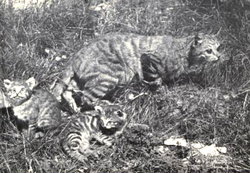Biology:Southern African wildcat
| Southern African wildcat | |
|---|---|

| |
| Southern African wildcat with kittens (Frederick William FitzSimons, 1919) | |
| Scientific classification | |
| Domain: | Eukaryota |
| Kingdom: | Animalia |
| Phylum: | Chordata |
| Class: | Mammalia |
| Order: | Carnivora |
| Suborder: | Feliformia |
| Family: | Felidae |
| Subfamily: | Felinae |
| Genus: | Felis |
| Species: | |
| Subspecies: | F. l. cafra
|
| Trinomial name | |
| Felis lybica cafra Desmarest, 1822
| |
The Southern African wildcat (Felis lybica cafra) is one of three subspecies of the African wildcat.[1] It is native to southern and southeastern Africa.[2] In 2007, it was tentatively recognised as a distinct subspecies on the basis of genetic analysis.[3] Morphological evidence suggests the break between the subspecies in African to occur in the south-east, in the area of Tanzania and Mozambique.[4]
In Afrikaans it is called 'vaalboskat'; in Swahili 'kaka mwiw', 'kimbum', or 'kaka pori'; in Herero 'ochawhi'; in Ndebele 'igola'.[5] It is also known in English as the 'bush cat'.[6]
Characteristics
The body of the Southern African wildcat is marked with vertical stripes but these can vary from faint to quite distinct. The tail is ringed with black and has a black tip. The chin and throat are white and the chest is usually paler than the rest of the body. The feet are jet black underneath. There are two colour phases; iron-grey, with black and whitish speckling, and tawny-grey, with less black and more buffy speckling.[2] In appearance it is very similar to a domestic cat, although the legs are proportionately longer. The most distinguishable characteristic is the rich reddish-brown colour on the backs of the ears, over the belly and on the back legs. Its body length is 46–66.5 cm (18.1–26.2 in) with a 25–36 cm (9.8–14.2 in) long tail; and weight range 2.4–5.5 kg (5.3–12.1 lb).[7]
Distribution and habitat
The Southern African wild cat is widely distributed throughout Africa south of the equator, but does not occur along the Namibian coast. It tolerates a wide range of habitats that provide some sort of cover.[2]
Ecology and behaviour
Southern African wildcats are largely nocturnal, finding cover in which to rest during the day. Their habits are solitary, except for mating and raising their young, and they are highly territorial. They are adaptable predators, preferring to hunt small rodents, but able to change their diet according to seasonal and longer-term prey abundances and availability; they have been observed to take other small mammals, birds, reptiles, amphibians, insects and other invertebrates.[8] The largest recorded prey include hares, springhares and birds up to the size of guineafowl.[9]
Threats
The main threat to the survival of the wild subspecies in its pure form is its tendency to interbreed with domestic cats anywhere near human habitations. Other threats include persecution by hunters and local farmers, as well as habitat loss.[10]
References
- ↑ Kitchener, A.C.; Breitenmoser-Würsten, C.; Eizirik, E.; Gentry, A.; Werdelin, L.; Wilting, A.; Yamaguchi, N. (2017). "A revised taxonomy of the Felidae: The final report of the Cat Classification Task Force of the IUCN Cat Specialist Group". Cat News Special Issue 11. http://www.catsg.org/fileadmin/filesharing/5.Cat_News/5.3._Special_Issues/5.3.10._SI_11/CN_Special_Issue_11_Revised_taxonomy_of_the_Felidae.pdf.
- ↑ 2.0 2.1 2.2 Pocock, R. I. (1951). "Felis lybica cafra". Catalogue of the Genus Felis. British Museum of Natural History, London. pp. 102–109. https://archive.org/stream/catalogueofgenus00brit#page/102/mode/2up.
- ↑ Driscoll, C. A., Menotti-Raymond, M., Roca, A. L., Hupe, K., Johnson, W. E., Geffen, E., Harley, E., Delibes, M., Pontier, D., Kitchener, A. C., Yamaguchi, N., O’Brien, S. J., Macdonald, D. (2007). "The near eastern origin of cat domestication". Science 317 (5837): 519–523. doi:10.1126/science.1139518. Bibcode: 2007Sci...317..519D.
- ↑ Kitchener, A.C. and Rees, E.E. (2009). "Modelling the dynamic biogeography of the wildcat: implications for taxonomy and conservation". Journal of Zoology 279 (2): 144–155.
- ↑ Nowell, K.; Jackson, P. (1996). Wild Cats: status survey and conservation action plan. IUCN/SSC Cat Specialist Group, Gland, Switzerland..
- ↑ Hamerton, D. Felis silvestris cafra (African wild cat). Biodiversity Explorer, Iziko Museums of South Africa
- ↑ Skinner, J. D. & Chimimba, C. T. (2005). The mammals of the southern African sub-region. Cambridge University Press..
- ↑ Herbst, M; Mills, M. G. L (2010). "The feeding habits of the Southern African wildcat, a facultative trophic specialist, in the southern Kalahari (Kgalagadi Transfrontier Park, South Africa/Botswana)". Journal of Zoology 280 (4): 403. doi:10.1111/j.1469-7998.2009.00679.x.
- ↑ Smithers, R. H. N. (1971). The Mammals of Botswana. Museum Memoir. 4. The Trustees of the National Museum of Rhodesia.
- ↑ Yamaguchi, N.; Kitchener, A.; Driscoll, C.; Nussberger, B. (2015). "Felis silvestris". The IUCN Red List of Threatened Species (IUCN) 2015: e.T60354712A50652361. doi:10.2305/IUCN.UK.2015-2.RLTS.T60354712A50652361.en. http://www.iucnredlist.org/details/60354712/0. Retrieved 15 January 2018.
Wikidata ☰ Q3643977 entry
